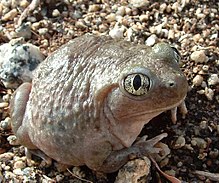| American spadefoot toad Temporal range: Paleocene to recent,
| |
|---|---|

| |
| Western spadefoot toad (Spea hammondii) | |
| Scientific classification | |
| Domain: | Eukaryota |
| Kingdom: | Animalia |
| Phylum: | Chordata |
| Class: | Amphibia |
| Order: | Anura |
| Suborder: | Mesobatrachia |
| Family: | Scaphiopodidae Cope, 1865 |
| Genera | |

| |
| Distribution of Scaphiopodidae (in black) | |

The Scaphiopodidae are a family of American spadefoot toads, which are native to North America. The family is small, comprising only eleven different species.
The American spadefoot toads are of typical shape to most fossorial (or burrowing) frogs. They are round, with short legs and protruding eyes. As suggested by their name, these frogs have hard, keratinous protrusions present on their feet, which help them to dig. Like most fossorial frogs, they dig backwards into the ground.[1] They differ from true toads because they have vertical pupils and no parotoid gland.[2]
The American spadefoot toads are terrestrial when not underground. They are dully colored, usually a grey or dull green or brown, to aid in camouflage in their arid habitats.
- ^ "Scaphiopodidae (Cope, 1865) American Spadefoot Toads". Archived from the original on 2006-08-30. Retrieved 2006-05-12.
- ^ "Idaho Fish and Game" (PDF). idfg.idaho.gov. Retrieved 2019-01-06.